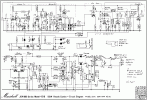Jason Patrick
New Member
- Joined
- Sep 21, 2024
- Messages
- 4
- Reaction score
- 2
Who has experience with working on these? This is an early one without the chip and I’m not to familiar with them and I’m fixing up a friends that sounded like crap cause the tubes were dead. I Cleaned the pots, installed new tubes, cleaned jacks, the normal procedures. Now it roars BUT, the volumes interactions are weird. The boost volume really affects the normal channel even with the boost off. I hear that this is an issue with these and is small potatoes for what I’m really trying to figure out. At certain settings of the volumes and gain, I’m getting a very starved fuzz pedal sound with like a ring modulator gated envelope type sound. When I play the guitar when it’s doing it, you really have to dig in to get a note to pop out. I noticed there are spots depending on how you tweek the gain and normal Chan volume where the volume drops out like there is high frequency oscillation going on. Lead dress is spot on, I did the chopstick poke poke, all components are in spec. I’m unfamiliar with amps using transistors tho, so I’m wondering could it be one of them? I can get great tone and crunch out of it but it just bothers me that I feel something is not right regardless. Oh and voltages seem to be golden. So, is this how these are with the diode clipping? I feel that’s where the problem may be. I usually fix old fender amps so this is a new one for me!
Thanks all!
Thanks all!
Last edited:



